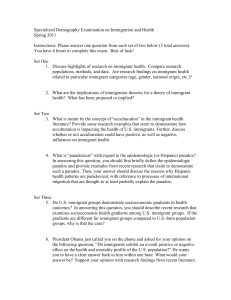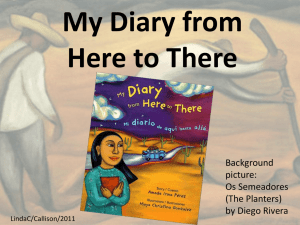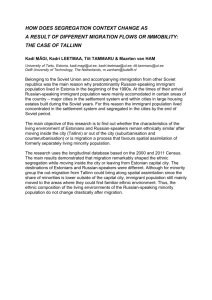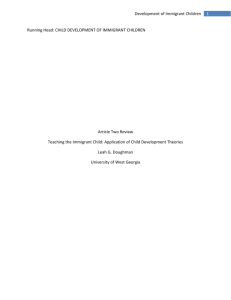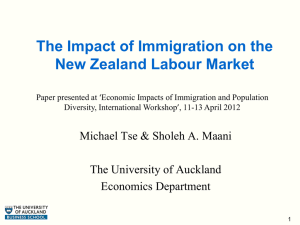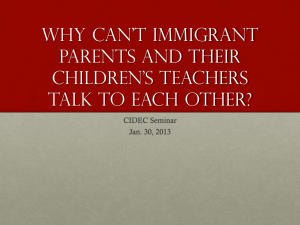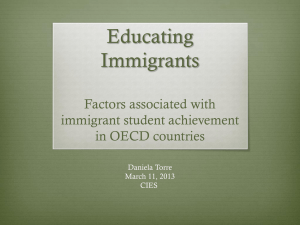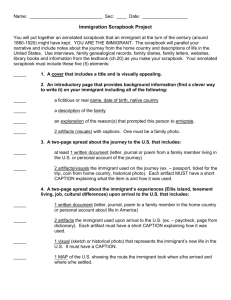Laurie Olsen *Made in America*
advertisement
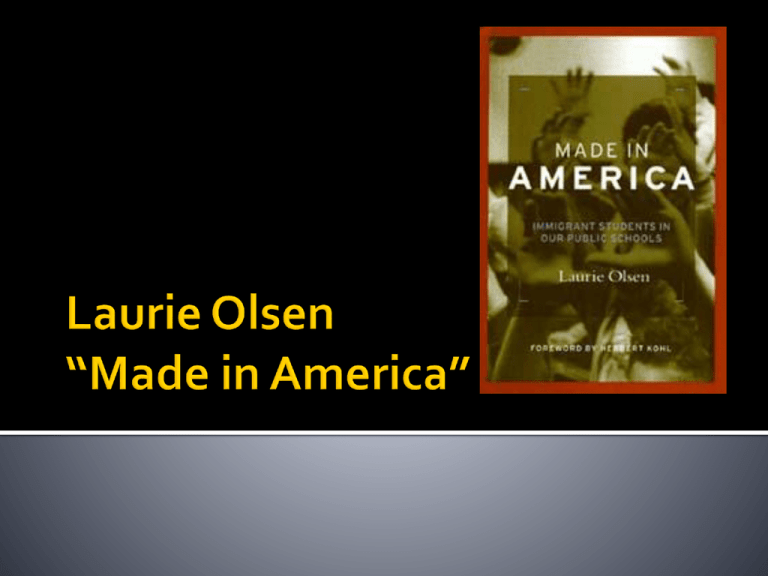
We are a wonderfully multilingual and multicultural nation. But we are not yet a fair nation. We continue to perpetuate language and cultural destruction. We have so much to gain by welcoming, supporting, listening to and learning from the voices encoded in each of our languages. -Laurie Olsen According to Olsen In the past decade, Madison High School has shifted from having primarily white working-class students to having a student enrollment that has no single majority ethnic group. It is a truly multicultural school that celebrates diversity. The school population is ¼ immigrant and the students speak 16 different languages. The article questions the status quo regarding race relations in the United States (specifically in southern California). The article reviews the struggles that immigrant students have in integrating into an Americanized society. The article explores how a students identity is formed. Exploring what it is like to go to school and to teach in school during a time of increasingly complex cultural relations and political dissension, and amidst the pressures of a large urban, fiscally strapped public school system. Ultimately this is the story of the latest chapter in a profound and mighty struggle within our United States. [1] How are we as a society going to respond to our diversity in this last decade of the 20th century? Will we embrace a diversity of cultures and languages, forging a strong, inclusive, and a united community? Or will we end up enforcing a more narrow and exclusive vision out of fear that diversity will weaken our cohesion? First, What they collude is in not seeing is the active process of exclusion and sorting that goes on in the school’s program and practice, a sorting that consigns students by skin color, class, and English fluency into positions of very unequal access to resources, opportunities, and education. [1] Second, The task of learning English is accompanied by another major taskbecoming racialized into our highly structured social order, where one’s position is determined by skin color. [1] In the process of “Americanizing” newcomers, all of us engage in a massive struggle over the values of this nation, the meaning of diversity, the content of our race and language relations, and our visions of fairness, democracy, and inclusion. [1] In the past decade, Madison has shifted from having primarily white workin-class students to having a student enrollment that has no single majority ethnic or racial group, speaks sixteen different home languages, and is almost onefourth immigrants. It is a truly multicultural high school campus that celebrates its diversity. [1] How is it that despite the rich multiculturalism of the people despite the creation of some programs and spaces that support a multicultural, the end product is still separation, conformity, and exclusion? [1] An Ethnographic Methodology For two years I simply spent time at Madison High in classrooms, on the Quad, observing life, and talking to people. I selected ten female students and five teachers to focus on in more depth over the two years of the project. I explicitly elected to focus on female students from differing cultural and social groupings in the school in order to illuminate relationships between gender and cultural reproduction. Because schools are one of the few public arenas in which established residents and immigrant newcomers engage in regular, sustained interactions, the school site is an essential point in that negotiation. Public schools of our nation have held forth a proud rhetoric and vision of access for all. The only potential for change is in the cultural production of the students themselves. The biographies of the following students: an Afghan immigrant, a Brazilian immigrant, a Latina (Mexican American) born in the United States, a Fijian Immigrant, an East Indian immigrant, a Vietnamese immigrant, a white student born in the local Bayview community, an African American student born in the United States, a Chinese immigrant, and a Mexican Immigrant. How did they understand “America”? What does it mean to be “American”? What borders and boundaries did they create or detect in social relations? What language did they use to articulate and create those borders and boundaries? How were the crossings, the borderlands and terrain in between languages, cultures, and national identities experienced shared contested? How did they experience and view their encounters with each other across languages cultures and national identity? What was it like for those students and teachers who felt themselves involved in forging new terrains of language, culture, racial, and national identity? Why were they in school, and how did they experience school? What relationship did school have to the rest of their lives? The research involved examining processes and mechanisms of decision making; language policy; student grouping; curriculum content; and the placement of students and enrollment in specific gatekeeping courses. The Storyteller The Anthropologist The Advocate The high academic classes are filled disproportionately with White, Vietnamese, and Chinese students. The “skills” remedial track is filled disproportionately with Latino and African American students. Americanization to newcomer students is an abandonment of hope that others will see and accept them in their full national, religious, and language identities. Students choose marginality as a means of resistance. They choose to remain off the social map, to remain “foreign,” and not give in to racial categories. But within two years, very few of the students followed in this research maintained this stance. …Certain racial groups that process appears to be accompanied by giving up their immigrant belief in the American dream” Those on the Latino “race track” more often gave up the immigrant ideology and belief in school success. Their peer group at Madison seldom appears in the college preparatory classes, has the lowest rate of school attendance, the highest rate of disciplinary referrals for truancy, the lowest grade point averages… Making a place for oneself and finding one’s race are central to student life at Madison. Newcomer students develop conscious skills for interaction, careful ways of behaving an habits of monitoring their own and each other’s behavior as they engage in this process. The schooling process itself segregates, excludes, and discriminates. This is an overt manifestation of a racial project at the school. But it is heavily denied and hidden. The social separation and the academic tracking are part and parcel of slotting students by skin color, language, and class into their places in a hierarchy in the world. Their belief in individual effort clouds their ability to see this sorting process. A complex issue such as this is virtually impossible to solve. However, if funding and research is present, and the willingness to overcome the boundaries that individuals of other cultures experience then there is the ability to have success. Start with the basics. Give teachers the tools to succeed. http://www.californiatomorrow.org/resources /downloads/index.php?cat_id=2

